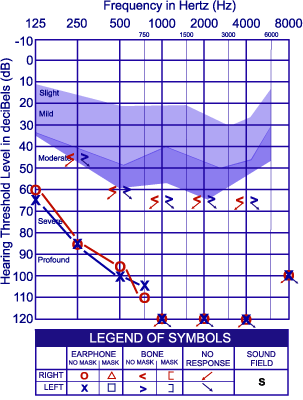Profound deafness
Anybody who cannot hear a sound below 90dB is profoundly deaf; some profoundly deaf people cannot hear anything at all, at any level of decibels. Communication is done with sign language and/or lip-reading.
(Please click here for further info on what dB sounds are.)
Sensorineural hearing loss
A sensorineural hearing loss is one caused by dysfunction of the inner ear, the cochlea, the nerve that transmits the impulses from the cochlea to the hearing centre in the brain or damage in the brain. The most common reason for sensorineural hearing impairment is damage to the hair cells in the cochlea.
Before language
Prelingual deafness is hearing impairment that is sustained before the acquisition of language, which can occur due to a congenital condition or through hearing loss in early infancy. Prelingual deafness impairs an individual’s ability to acquire a spoken language.
Here is a similar audiogram to mine but my low frequencies start at about 90-100dB and then they disappear completely at about 1000Hz!
Bilateral Profound Sensorineural Hearing Loss

Image courtesy of EDEN – The Electronic Deaf Education Network
This audiogram shows a bilateral profound sensorineural hearing loss.
- Bilateral means that both ears have a hearing loss.
- Profound means that the hearing loss is 90dB or greater. This means that the child may not be able to hear anything softer than 90dB.
- Sensorineural means that the cochlea or auditory nerve isn’t working correctly.
This kind of hearing loss is sometimes called a “Left Corner” audiogram.
A child with this much hearing loss may not be able to hear much, even with hearing aids. So he may not be able to learn to speak through hearing alone. He may benefit from using sign language and by reading lips. He may also be a candidate for a cochlear implant.
Copied from http://www.raisingdeafkids.org/hearingloss/testing/audiogram/corner.php
